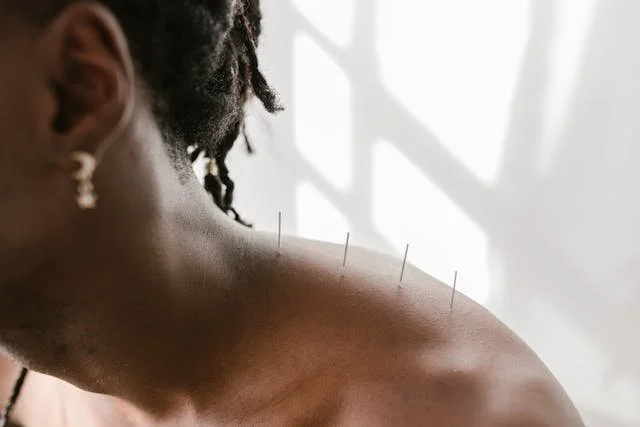Dry Needling vs. Acupuncture: Understanding the Difference
If you've been exploring treatment options for muscle pain, tension, or movement dysfunction, you may have come across both dry needling and acupuncture. While both techniques use thin needles inserted into the skin, they're actually quite different in their approach, purpose, and underlying philosophy. At Well Equipt Physical Therapy, we want to help you understand these differences so you can make informed decisions about your care.
What Is Dry Needling?
Dry needling is a modern, Western medicine technique used by physical therapists and other healthcare providers to treat myofascial pain and muscle dysfunction. The term "dry" simply means that nothing is injected through the needle; it's the needle insertion itself that provides the therapeutic effect.
During dry needling, your physical therapist inserts a thin filament needle directly into myofascial trigger points - those tight, knotted areas in your muscles that can cause pain and restrict movement. The goal is to release muscle tension, improve blood flow, decrease pain, and restore normal muscle function.
How Dry Needling Works
The exact mechanisms are still being studied, but dry needling appears to work by:
Disrupting dysfunctional muscle contraction patterns
Reducing local inflammation and pain chemicals
Improving blood circulation to the affected area
Stimulating a local twitch response that helps reset muscle tension
Promoting the body's natural healing processes
What Conditions Can Dry Needling Treat?
At Well Equipt Physical Therapy, we commonly use dry needling to address:
Chronic neck and back pain
Shoulder pain and rotator cuff issues
Tennis elbow and golfer's elbow
Headaches and migraines (especially tension-type)
Plantar fasciitis
Sciatica and nerve pain
Sports injuries and muscle strains
Post-surgical pain and scar tissue
TMJ dysfunction
What Is Acupuncture?
Acupuncture is an ancient practice rooted in Traditional Chinese Medicine (TCM), with a history spanning thousands of years. This holistic approach is based on the concept of "qi" (pronounced "chee") - the vital energy that flows through pathways in the body called meridians.
According to TCM philosophy, illness and pain occur when qi becomes blocked or imbalanced. Acupuncturists insert needles at specific points along these meridians to restore the proper flow of energy, promoting healing and overall wellness.
The Philosophy Behind Acupuncture
Acupuncture takes a whole-body approach to health, considering not just physical symptoms but also emotional, mental, and spiritual wellbeing. Practitioners may assess your pulse, tongue, and other diagnostic indicators to determine your unique pattern of imbalance before selecting treatment points.
What Can Acupuncture Treat?
Acupuncture is used for a wide range of conditions, including:
Chronic pain conditions
Digestive issues
Anxiety and stress
Insomnia
Fertility concerns
Allergies and sinus problems
General wellness and prevention
Key Differences Between Dry Needling and Acupuncture
Philosophy and Approach
Dry Needling: Based on modern Western medicine and anatomy. Focuses on the neuromuscular system, trigger points, and pain science.
Acupuncture: Based on Traditional Chinese Medicine and the concept of energy meridians and qi flow.
Training and Practitioners
Dry Needling: Performed by physical therapists, chiropractors, and some medical doctors who have completed specialized training in the technique. At Well Equipt Physical Therapy, our therapists undergo extensive dry needling certification.
Acupuncture: Performed by licensed acupuncturists who complete years of training in TCM theory and practice, typically requiring a master's degree and state licensure.
Needle Placement
Dry Needling: Needles are placed directly into muscle trigger points, tender areas, or along tight muscle bands based on anatomical and biomechanical assessment.
Acupuncture: Needles are placed at specific acupuncture points along meridians, which may or may not correspond to the area of pain or complaint.
Treatment Goals
Dry Needling: Primarily aims to release muscle tension, improve movement patterns, and reduce musculoskeletal pain as part of a comprehensive physical therapy treatment plan.
Acupuncture: Aims to restore balance and energy flow throughout the body, addressing both symptoms and underlying imbalances for overall wellness.
Integration with Other Treatments
Dry Needling: Typically used as one component of physical therapy, alongside manual therapy, therapeutic exercise, and functional training.
Acupuncture: Often used as a standalone treatment, though it may be combined with other TCM practices like cupping or herbal medicine.
Can Both Be Effective?
The short answer is yes - both techniques can be effective, though they work through different mechanisms and are appropriate for different situations. Research supports the use of both dry needling and acupuncture for various pain conditions, though the evidence continues to evolve.
The best choice for you depends on your specific condition, treatment goals, and personal preferences. Some people prefer the evidence-based, anatomy-focused approach of dry needling, while others resonate with the holistic philosophy of acupuncture.
Dry Needling at Well Equipt Physical Therapy
At Well Equipt Physical Therapy, we incorporate dry needling as part of comprehensive, individualized treatment plans. Our certified physical therapists use dry needling alongside other proven techniques to help you:
Reduce pain and muscle tension
Improve range of motion and flexibility
Accelerate recovery from injury
Enhance athletic performance
Return to the activities you love
We take the time to assess your unique needs, explain your treatment options, and develop a plan that addresses not just your symptoms but also the underlying movement dysfunctions contributing to your pain.
What to Expect During Dry Needling
If you're considering dry needling, here's what typically happens:
Assessment: Your physical therapist will evaluate your movement patterns, identify trigger points, and explain how dry needling can help.
Treatment: Thin needles are inserted into targeted areas. You may feel a brief pinch, followed by a deep ache or muscle twitch; this is normal and indicates the trigger point is responding.
Integration: Dry needling is combined with other therapies like manual techniques, stretching, or strengthening exercises for optimal results.
Follow-up: Most patients need multiple sessions, with many noticing improvement after just a few treatments.
Want a deeper view? Check out our detailed article on what to expect during and after treatment.
Making Your Decision
Both dry needling and acupuncture have their place in pain management and healing. The key is finding the approach that aligns with your needs, beliefs, and treatment goals.
If you're dealing with musculoskeletal pain, sports injuries, or movement limitations and want an evidence-based approach integrated with physical therapy, dry needling at Well Equipt Physical Therapy may be the right choice for you.
If you're interested in a holistic approach that addresses overall wellness and energy balance, acupuncture with a licensed acupuncturist might be more appropriate.
Ready to Explore Dry Needling?
At Well Equipt Physical Therapy, we're committed to providing cutting-edge, evidence-based care to help you move better and feel better. If you're curious about whether dry needling could help with your pain or movement challenges, we'd love to hear from you.
Call 678-631-7925 or contact us today to schedule a consultation and learn more about how dry needling can be part of your personalized treatment plan. Your journey to better movement starts here.
Have questions about dry needling or other physical therapy services? Reach out to our team at Well Equipt Physical Therapy; we're here to help you achieve your goals.



